spring security 学习一
1、配置基本的springboot web项目,加入security5依赖,启动项目
浏览器访问,即可出现一个默认的登录页面

2、什么都没有配置 登录页面哪里来的
一般不知从何入手,就看官方文档里是如何做的,官方的文档和api 是最好最完整的介绍和参考,点击链接查看官方文档地址
(https://docs.spring.io/spring-security/site/docs/current/reference/htmlsingle/#jc-oauth2login),或者通过Google 搜索 spring security,
在结果中点击Spring Security Reference,点击进入页面,然后就可以看到关于Spring Security的文档;
通过查看文档发现,WebSecurityConfigurerAdapter 提供的默认的配置,config(HttpSecurty http)中的formLogin(),这个方法内容如下:
public FormLoginConfigurer<HttpSecurity> formLogin() throws Exception { return (FormLoginConfigurer)this.getOrApply(new FormLoginConfigurer()); }
查看formLogin()源码,跳转到HttpSecurity类中,这个方法返回一个FormLoginConfigurer<HttpSercurity>类型的数据。再继续来看看这
个FormLoginConfigurer,在FormLoginConfigurer中有个initDefaultLoginFilter()方法:
private void initDefaultLoginFilter(H http) { DefaultLoginPageGeneratingFilter loginPageGeneratingFilter = (DefaultLoginPageGeneratingFilter)http.getSharedObject(DefaultLoginPageGeneratingFilter.class); if (loginPageGeneratingFilter != null && !this.isCustomLoginPage()) { loginPageGeneratingFilter.setFormLoginEnabled(true); loginPageGeneratingFilter.setUsernameParameter(this.getUsernameParameter()); loginPageGeneratingFilter.setPasswordParameter(this.getPasswordParameter()); loginPageGeneratingFilter.setLoginPageUrl(this.getLoginPage()); loginPageGeneratingFilter.setFailureUrl(this.getFailureUrl()); loginPageGeneratingFilter.setAuthenticationUrl(this.getLoginProcessingUrl()); } }
这个方法,初始化一个默认登录页的过滤器,可以看到第一句代码,默认的过滤器是DefaultLoginPageGeneratingFilter,下面是设置一些必要的参数,进入到这个过滤器中:
在描述中可以看到,如果没有配置login页,这个过滤器会被创建,过滤器创建后再浏览器访问的时候回指定doFilter()方法:
public void doFilter(ServletRequest req, ServletResponse res, FilterChain chain) throws IOException, ServletException { HttpServletRequest request = (HttpServletRequest) req; HttpServletResponse response = (HttpServletResponse) res; boolean loginError = isErrorPage(request); boolean logoutSuccess = isLogoutSuccess(request); if (isLoginUrlRequest(request) || loginError || logoutSuccess) { String loginPageHtml = generateLoginPageHtml(request, loginError, logoutSuccess); response.setContentType("text/html;charset=UTF-8"); response.setContentLength(loginPageHtml.getBytes(StandardCharsets.UTF_8).length); response.getWriter().write(loginPageHtml); return; } chain.doFilter(request, response); }
登录页面的配置是通过generateLoginPageHtml()方法创建的,再来看看这个方法内容:
private String generateLoginPageHtml(HttpServletRequest request, boolean loginError, boolean logoutSuccess) { String errorMsg = "Invalid credentials"; if (loginError) { HttpSession session = request.getSession(false); if (session != null) { AuthenticationException ex = (AuthenticationException) session .getAttribute(WebAttributes.AUTHENTICATION_EXCEPTION); errorMsg = ex != null ? ex.getMessage() : "Invalid credentials"; } } StringBuilder sb = new StringBuilder(); sb.append("<!DOCTYPE html>\n" + "<html lang=\"en\">\n" + " <head>\n" + " <meta charset=\"utf-8\">\n" + " <meta name=\"viewport\" content=\"width=device-width, initial-scale=1, shrink-to-fit=no\">\n" + " <meta name=\"description\" content=\"\">\n" + " <meta name=\"author\" content=\"\">\n" + " <title>Please sign in</title>\n" + " <link href=\"https://maxcdn.bootstrapcdn.com/bootstrap/4.0.0-beta/css/bootstrap.min.css\" rel=\"stylesheet\" integrity=\"sha384-/Y6pD6FV/Vv2HJnA6t+vslU6fwYXjCFtcEpHbNJ0lyAFsXTsjBbfaDjzALeQsN6M\" crossorigin=\"anonymous\">\n" + " <link href=\"https://getbootstrap.com/docs/4.0/examples/signin/signin.css\" rel=\"stylesheet\" crossorigin=\"anonymous\"/>\n" + " </head>\n" + " <body>\n" + " <div class=\"container\">\n"); String contextPath = request.getContextPath(); if (this.formLoginEnabled) { sb.append(" <form class=\"form-signin\" method=\"post\" action=\"" + contextPath + this.authenticationUrl + "\">\n" + " <h2 class=\"form-signin-heading\">Please sign in</h2>\n" + createError(loginError, errorMsg) + createLogoutSuccess(logoutSuccess) + " <p>\n" + " <label for=\"username\" class=\"sr-only\">Username</label>\n" + " <input type=\"text\" id=\"username\" name=\"" + this.usernameParameter + "\" class=\"form-control\" placeholder=\"Username\" required autofocus>\n" + " </p>\n" + " <p>\n" + " <label for=\"password\" class=\"sr-only\">Password</label>\n" + " <input type=\"password\" id=\"password\" name=\"" + this.passwordParameter + "\" class=\"form-control\" placeholder=\"Password\" required>\n" + " </p>\n" + createRememberMe(this.rememberMeParameter) + renderHiddenInputs(request) + " <button class=\"btn btn-lg btn-primary btn-block\" type=\"submit\">Sign in</button>\n" + " </form>\n"); } if (openIdEnabled) { sb.append(" <form name=\"oidf\" class=\"form-signin\" method=\"post\" action=\"" + contextPath + this.openIDauthenticationUrl + "\">\n" + " <h2 class=\"form-signin-heading\">Login with OpenID Identity</h2>\n" + createError(loginError, errorMsg) + createLogoutSuccess(logoutSuccess) + " <p>\n" + " <label for=\"username\" class=\"sr-only\">Identity</label>\n" + " <input type=\"text\" id=\"username\" name=\"" + this.openIDusernameParameter + "\" class=\"form-control\" placeholder=\"Username\" required autofocus>\n" + " </p>\n" + createRememberMe(this.openIDrememberMeParameter) + renderHiddenInputs(request) + " <button class=\"btn btn-lg btn-primary btn-block\" type=\"submit\">Sign in</button>\n" + " </form>\n"); } if (oauth2LoginEnabled) { sb.append("<h2 class=\"form-signin-heading\">Login with OAuth 2.0</h2>"); sb.append(createError(loginError, errorMsg)); sb.append(createLogoutSuccess(logoutSuccess)); sb.append("<table class=\"table table-striped\">\n"); for (Map.Entry<String, String> clientAuthenticationUrlToClientName : oauth2AuthenticationUrlToClientName.entrySet()) { sb.append(" <tr><td>"); String url = clientAuthenticationUrlToClientName.getKey(); sb.append("<a href=\"").append(contextPath).append(url).append("\">"); String clientName = HtmlUtils.htmlEscape(clientAuthenticationUrlToClientName.getValue()); sb.append(clientName); sb.append("</a>"); sb.append("</td></tr>\n"); } sb.append("</table>\n"); } sb.append("</div>\n"); sb.append("</body></html>"); return sb.toString(); }
3、去掉默认的登录页,修改application.yml,添加一下内容(在security5中不在支持以下配置,而是提供一个自定义的WebSecurityConfigurer文件)
The security auto-configuration is no longer customizable. Provide your own WebSecurityConfigurer bean instead.
security: basic: enabled: false
4、自定义WebSecurityConfigurer
以下配置是创建一个最简单的基于form表单认证的security
formLogin():指定认证为form表单
authorizeRequests():授权
anyRequest():任何请求
authenticated():都需要认证
@Configuration
public class CusWebSecurityConfig extends WebSecurityConfigurerAdapter { @Override protected void configure(HttpSecurity http) throws Exception { http.formLogin()//指定是表单登录 .and().authorizeRequests()//授权 .anyRequest()//任何请求 .authenticated();//都需要身份认证 } }
5、基本流程

过滤器链有以下:
①UsernamePasswordAuthenticationFilter
在过滤器容器中判断请求中是否有用户名和密码,如果有用户名和密码就会使用UsernamePasswordAuthenticationFilter这个过滤器,如果没有就会走下一个过滤器
②BasicAuthenticationFilter
在这个过滤器中回尝试获取请求头中是否有basic开头的Authentication信息,如果有
就会尝试解码,处理完成之后会走下一个filter
③ExceptionTranslationFilter
这个过滤器的作用是用来捕获下边这个FilterSecurityInterceptor抛出的异常
④FilterSecurityInterceptor
这个拦截器是过滤器链中的最后一环,在这个里边会判断当前请求能否访问controller,
能否访问是根据securityconfig配置来判断的
即:

6、源码学习
FilterSecurityInterceptor关键源码
在invoke方法中有一个super.beforeInvocation方法,如上图,绿色的过滤器链都是在这个方法中进行处理的
public void invoke(FilterInvocation fi) throws IOException, ServletException { if ((fi.getRequest() != null) && (fi.getRequest().getAttribute(FILTER_APPLIED) != null) && observeOncePerRequest) { // filter already applied to this request and user wants us to observe // once-per-request handling, so don't re-do security checking fi.getChain().doFilter(fi.getRequest(), fi.getResponse()); } else { // first time this request being called, so perform security checking if (fi.getRequest() != null && observeOncePerRequest) { fi.getRequest().setAttribute(FILTER_APPLIED, Boolean.TRUE); } InterceptorStatusToken token = super.beforeInvocation(fi); try { fi.getChain().doFilter(fi.getRequest(), fi.getResponse()); } finally { super.finallyInvocation(token); } super.afterInvocation(token, null); } }
当访问api:localhost:9999/h 时,请求回走到FIlterSecurityInterceptor中的beforeInvocation处
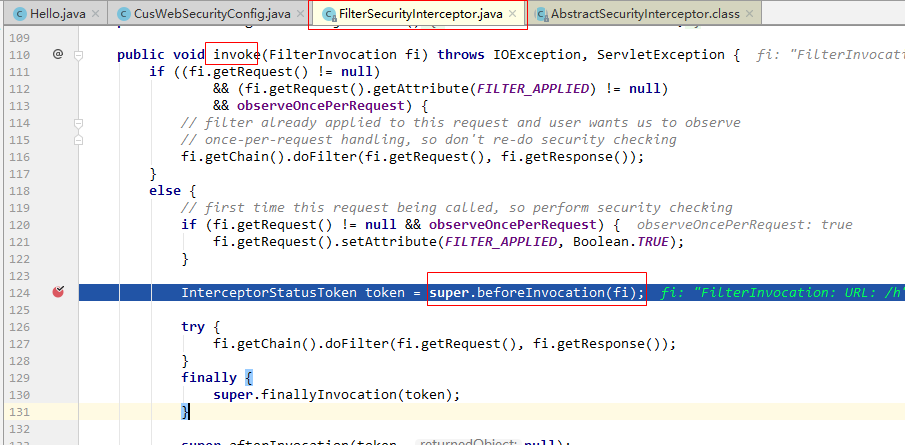
因为自己的securityConfig的是所有的请求都需要进行认证,因此在执行befoeInvocation的时候会抛出一个异常,也就是进入了ExceptionTranlationFilter中(因为没有经过认证,不能访问api)

在ExceptionTranlationFilter对异常进行处理,也就是把请求重定向到login页面上。

在登录页面填写登录名和密码(user/4ed8dccc-9425-4f92-8b12-0bac0d88793b,密码后台日志会2自动输出),填写完毕后点击登录,又因为使用的是form表单登录,所以会进入到UserNamePasswordAuthenticationFilter中,
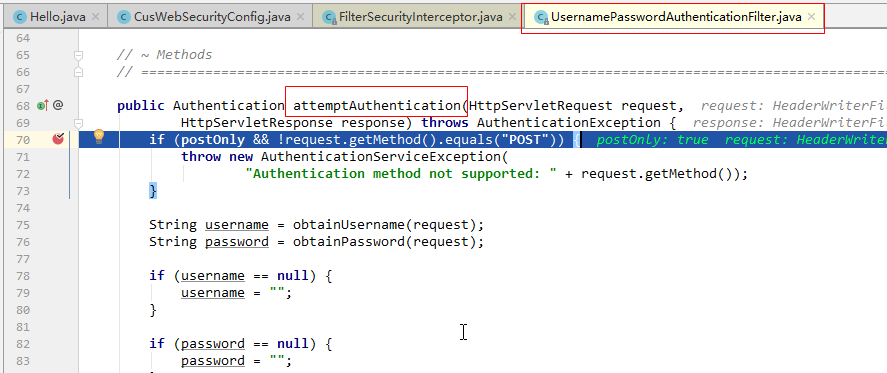
在UsernamepasswordAuthenticationFilter中执行完毕后,回再次进入到FilterSecurityInteceptor中的beforeInvocation处,此时执行到该处是不会报错,回向下继续进行。
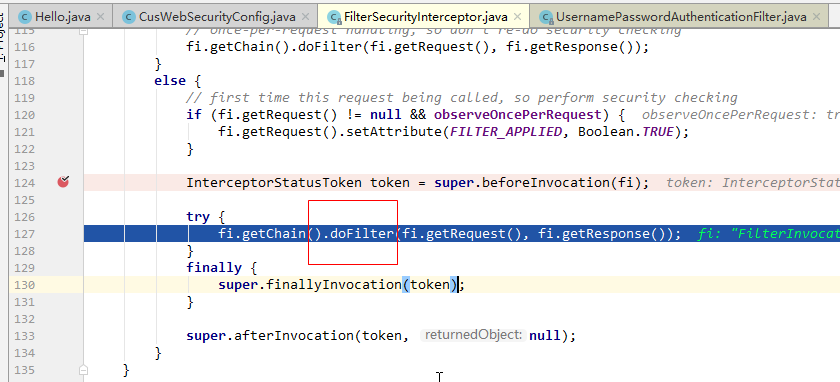
调用doFilter,也就是进入了自己写的api接口中(controller中)
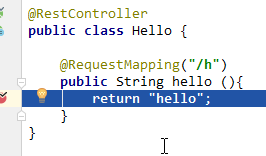
整个的流程:FilterSecurityInterceptor拦截请求,没有认证,重定向到默认的form认证页面(login),在登录页面输入用户名密码,点击登录后,会进入到UsernamePasswordAuthenticationFilter中(因为使用的form表单认证,如果使用其他认证的话,会进入到其他Filter中),在UsernamePasswordAuthenticationFilter中执行完毕后,回再次进入FIlterSecurityInterceptor中,执行没问题后,最终到controller层中的api处
自定义认证逻辑
一、处理用户信息获取逻辑
在security中用户信息的获取中,提供了一个接口UserDetailService,该接口中只有一个方法loadUserByUsername,返回参数是一个UserDetail
UserDetails loadUserByUsername(String username) throws UsernameNotFoundException;
在获取用户信息是,只需要关注一点即,获取UserDetail用户信息,之后的认证都是基于此对象的,
当查不到一个username是,会抛出一个UsernameNotFoundException异常,可以进行异常统一拦截
1、新建MyUserDetailsService(数据都是写死的)
(ps:security5好像不能只写一个userdetailservice就行运行,也得配一个PasswordEncoder,即在security配置文件中添加)
@Component @Slf4j public class MyUserDetailsService implements UserDetailsService { @Override public UserDetails loadUserByUsername(String s) throws UsernameNotFoundException { //根据username查找用户信息,在这,先手动写一个user信息 log.info("查找用户信息{}", s);
//密码在security5中好像得加密 不加密的话会爆粗(不确定)
BCryptPasswordEncoder encoder = new BCryptPasswordEncoder();
String password = encoder.encode("password");
//这个user对象使用的是security中的user对象,此对象已经实现了userDetail接口 //user前两个参数是进行认证的,第三个参数是当前用户所拥有的权限,security回根据授权代码进行验证 return new User(s, password, AuthorityUtils.commaSeparatedStringToAuthorityList("admin")); // AuthorityUtils.commaSeparatedStringToAuthorityList 这个方法是将一个字符一“,” 分割开 } }
//passwordEncoder
@Override protected void configure(AuthenticationManagerBuilder auth) throws Exception { auth.userDetailsService(myUserDetailsService) .passwordEncoder(new BCryptPasswordEncoder()); }
添加w完毕后,访问localhost:9999/h api,先回跳转到默认登录页面:
随便输入username和password:会出现bad credentials信息

如果密码输入password(后台user自定义加密后的password):会登录成功,并会执行controller
二、处理用户校验逻辑
1、 用户的校验逻辑主要就是比较密码是否匹配,这一块有security自动匹配(即将user信息放到Userdetail解耦的实现类中即可)
2、账号是否过期、是否被锁定、是否可用,这几个校验都可以重新以下方法(如果没有对应的逻辑,永远返回true即可)
boolean isAccountNonExpired();//账号没有过期 如果不需要的话,改为true,没有过期 boolean isAccountNonLocked(); //账号没有锁定锁定 boolean isCredentialsNonExpired();//密码是否过期了 boolean isEnabled();//这个可以配到库中
3、自己测试
修改loadUserByUsername方法的返回参数
①accountNonLock设为false
@Component @Slf4j public class MyUserDetailsService implements UserDetailsService { @Override public UserDetails loadUserByUsername(String s) throws UsernameNotFoundException { //根据username查找用户信息,在这,先手动写一个user信息 log.info("查找用户信息{}", s); BCryptPasswordEncoder encoder = new BCryptPasswordEncoder(); String password = encoder.encode("password"); //user前两个参数是进行认证的,第三个参数是当前用户所拥有的权限,security回根据授权代码进行验证 return new User(s, password, true, true, true, false, AuthorityUtils.commaSeparatedStringToAuthorityList("admin")); // AuthorityUtils.commaSeparatedStringToAuthorityList 这个方法是将一个字符一“,” 分割开 } }
修改问之后,重启测试用的项目后,方法api,输入用户密码后,提示已被锁定(即accountNonLock属性被设为false)
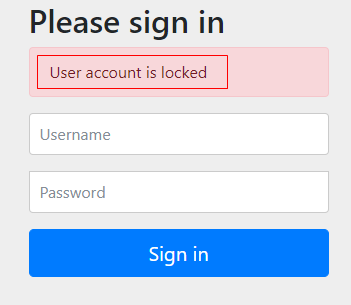
三、处理密码加密解密
以下两种方式,都可以使用到加密
@Override protected void configure(AuthenticationManagerBuilder auth) throws Exception { auth.userDetailsService(myUserDetailsService) .passwordEncoder(new BCryptPasswordEncoder()); }
或:
@Bean public PasswordEncoder passwordEncoder(){ return new BCryptPasswordEncoder(); }

